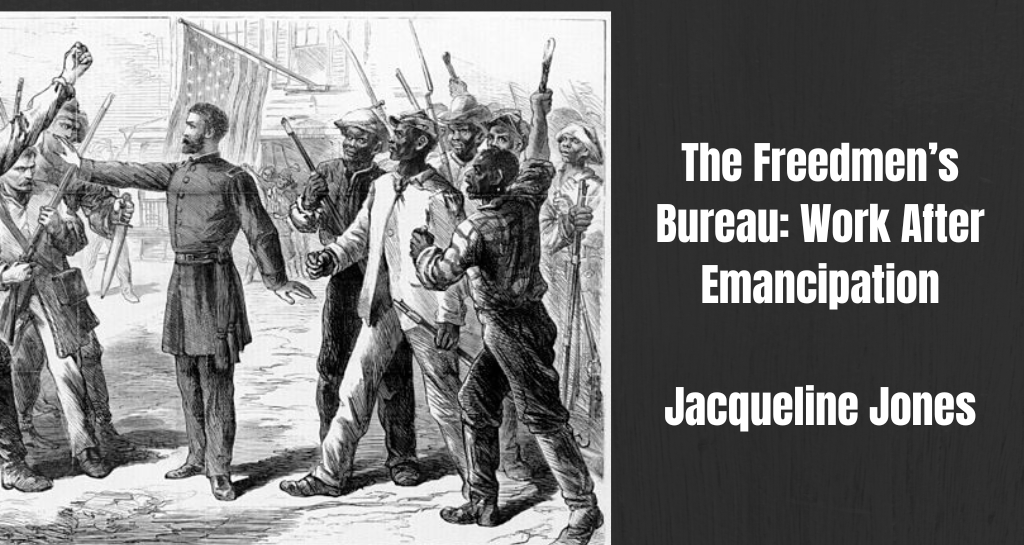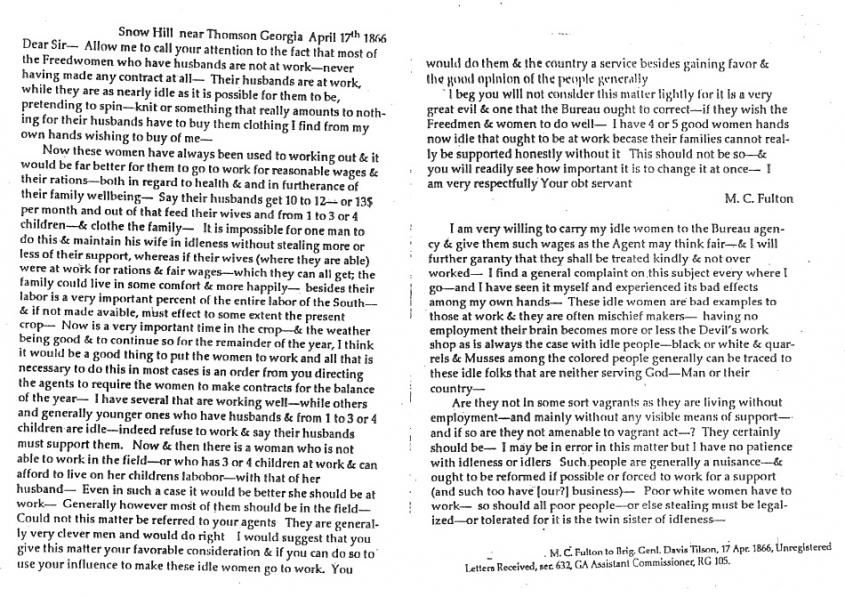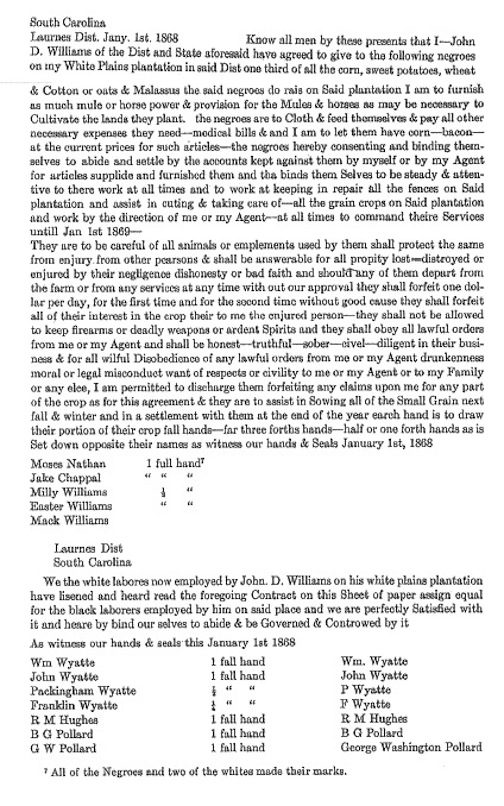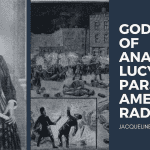
In March 1865, the U. S. Congress created the Freedmen’s Bureau for Refugees, Freedmen, and Abandoned Lands to ease the transition between slavery and freedom for 3.5 million newly liberated slaves. The bureau had three main functions—to distribute rations to Southerners who had been loyal to the Union during the Civil War, to establish public schools for black children and adults, and to oversee labor contracts between landowners and black workers.

Alfred R. Waud, “The Freedmen’s Bureau,” Harper’s Weekly (July 25, 1868)
Federal officials put great faith in annual labor contracts as a means to resume cotton staple-crop production in the South; get black workers back into the fields; and protect freed men, women and children from abusive employers. Typically, a worker would sign an agreement with an employer on January 1, and promise to work for the full calendar year. On December 31, the landowner would “reckon”—that is, tally up the amount of money the worker owed the employer for credits and supplies advanced to him during the year, the amount of cotton the worker and his family had produced, and the amount of money owed the worker from his share (usually one-third) of the crop. Northern whites in general assumed that these contracts would encourage white planters, many of whom had been slave owners, to treat their workers fairly and to refrain from coercive practices such as whippings and beatings that had been a hallmark of the institution of bondage. However, the bureau was chronically understaffed, and enforcement of labor contracts was difficult, since most bureau agents were stationed in towns, far away from isolated plantations.
The two documents below illustrate some of the limits and unanticipated consequences of these labor contracts. In the first, a letter to a Freedmen’s Bureau official, a Georgia planter named M. C. Fulton complains that the black women on his plantation are staying at home and not working in the fields as they had under slavery. He writes, “Now these women have always been used to working out & it would be far better for them to go to work for reasonable wages & their rations—both in regard to health & in furtherance of their family wellbeing.” This planter, like many others in the postbellum South, feared that the large-scale withdrawal of black women from the cotton fields would hinder the South’s ability to achieve pre-war cotton production levels.
As you read the document, note Fulton’s argument that these women “are as nearly idle as it is possible for them to be.” What are they doing? Are they in fact “idle”? According to Fulton, what is the danger of having these wives dependent upon their husbands for support? Can you think of reasons why these women would not want to work in the fields, and why their husbands would support them in this decision? How does Fulton seek to ingratiate himself with General Tillson? Does Fulton’s argue that only black women should have to work in the fields? Note his last sentence: What is he saying about class relations in the South?
The second document is a labor contract for employees on the South Carolina plantation of John D. Williams. Williams goes over the detailed terms of the agreement, at the outset stating his responsibilities, and then launching into a long list of behaviors he deems unacceptable among his workers. He notes that if any worker violates the terms of the agreement, he (Williams) reserves the right to fire that worker and deprive him of his share of the crop. In most cases a fired worker also lost his home, since most sharecroppers lived on the plantations where they worked. Williams probably assembled his workers together this day (Jan. 1, 1868), and read the contract to them, since a note at the bottom reveals that all of the black “signers” were illiterate. The last part of the contract indicates that black people were not the only southern workers to become caught up in the cycle of debt and dependency that flowed from the sharecropping system. A group of white men also signed this contract; their names are listed separately at the bottom of the document.
What are the stipulations governing the responsibilities and behavior of Williams’s sharecroppers, as outlined in this contract? In what ways are these rules broadly—and vaguely—defined? What power did Williams retain over his workers? What was their recourse, if he treated them badly or failed to live up to his contractual obligations? What is the significance of the fact that seven whites also signed this contract? Although black families were trapped in the sharecropping system in disproportionately large numbers, many white families too became landless after the war, and they too worked as sharecroppers. In fact, by 1930, southern white sharecropping households outnumbered their black counterparts.
These two documents suggest that the federal officials who conceived postwar labor contracts for the freedpeople were either naïve or overly optimistic about the role of the contract as a means to protect the economic interests of the former slaves. The annual contract was not really appropriate for the cultivation of a crop that consumed only a part of the year—April to November—leaving the rest of the year a source of conflict between worker and employer. Black fathers and sons often left the plantation in the winter or early spring to seek wage-work elsewhere, while employers wanted them to remain and work on fences or perform other “off-season” tasks. Many landlords engaged in abusive or fraudulent conduct toward their employees, making it difficult for black families to leave one place and find a better place down the road. And finally, very few sharecroppers were able to purchase even small parcels of land; most received no cash wages for their year’s labor, and many whites refused to sell land to blacks at any price.
DOCUMENTS:
To read more about Reconstruction:
Leon Litwack, Been in the Storm so Long: The Aftermath of Slavery (1980)
Eric Foner, Reconstruction: America’s Unfinished Revolution (2005)
John Hope Franklin, Reconstruction After the Civil War (1961-1994)
Charles Lane, The Day Freedom died: The Colfax Massacre, the Supreme Court, and the Betrayal of Reconstruction (2004)
Darlene Clark Hine, Hine Sight: Black Women and the Re-Construction of American History (1997)
Carol Faulkner, Women’s Radical Reconstruction: The Freedman’s Aid Movement (2007)
You may also like:
Jacqueline Jones on Civil War Savannah (NEP, January 2011)
Daina Ramey Berry on Slavery, Work, and Sexuality (NEP, October 2011)
Enslaved Life and Labor in the US (NEP October 2011)
Document Sources:
The Contract: Rosser H. Taylor, “Post-Bellum Southern Rental Contracts,” Agricultural History 17 (1943):122-3
The Fulton letter: M. C. Fulton to Brig. General Davis Tillson, 17 April, 1866, Unregistered Letters Received, Georgia Assistant Commissioner, Record Group 105 (Records of the Bureau of Freedmen, Refugees, and Abandoned Lands), National Archives, Washington, D. C.





